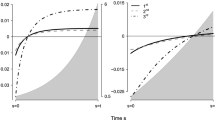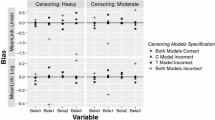Abstract
Introduction: Frequently, within economic evaluations, data are subject to censoring, and ignoring censored data will lead to an underestimation of mean total costs. Several techniques have been published that can be used to estimate mean total costs and standard errors, and allow for censoring within cost data. This paper reviews these techniques and compares the mean total costs estimates generated by each method for different types of censoring.
Methods: Nine techniques were identified that can be used to estimate mean total costs and standard errors in the presence of censoring: ignoring censoring; ignoring censored costs; Lin’s method — with and without cost histories; weighted cost method — with and without cost histories; Lin’s regression method — with and without cost histories; and Carides’ regression method. These methods are compared across four different censoring mechanisms — random censoring, end-of-study censoring, informative censoring and partial censoring — by simulating the censoring mechanisms from a complete cohort of patients included in the CELT (Cost Effectiveness of Liver Transplantation) study.
Results: The observed mean cost and standard error from the CELT data were £36 045 and £1517 (1998 values). Estimates under informative censoring were the least accurate predictors of mean total costs and tended to overestimate mean costs by >£1000. Carides’ regression method predicted mean total costs to within £3 of the observed mean and represented one of the three most accurate methods for predicting mean total costs (together with the weighted cost method with known cost histories and Lin’s method with unknown cost histories). Lin’s method with known cost histories gave the least accurate estimates of mean total costs and underpredicted costs by £2137–4859 across censoring mechanisms. Carides’ method did not predict uncertainty around the mean costs well, and the weighted cost method with known cost histories and ignoring censoring were the best methods to use for estimating the standard error of the mean cost.
Conclusions: Further work should be carried out on other datasets to confirm the generalisability of these results. Although Carides’ regression method and Lin’s method with unknown cost histories were the best estimators of mean total costs across censoring mechanisms, the weighted cost method with known cost histories is the preferred method for obtaining an accurate estimate of the mean total cost alone and the uncertainty surrounding it; therefore, it should be used to estimate mean costs and standard errors when patient cost histories are known.





Similar content being viewed by others
Notes
In this paper, an estimator refers to the underlying method (mathematical formula) applied to the cost data to account for censored costs.
Cost data are said to have cost histories when the detail of resource collection is such that information on the time each resource is used is collected alongside information on the quantity of each resource.
Data are right censored when the event of interest occurs at some timepoint after the last known observation.
The percentile distribution is obtained by ordering continuous data from smallest to largest values, and a value on the scale indicates a percentage of the distribution that is equal to or below that value.
References
Collett D. Modelling survival data in medical research. London: Chapman & Hall, 1994
Kaplan EL, Meier P. Nonparametric estimation from incomplete observations. J Am Stat Assoc 1958; 53: 457–81
Cox D. Regression models and life tables (with discussion). J R Stat Soc B 1972; 34 (2): 187–220
Hallstrom AP, Sullivan SD. On estimating costs for economic evaluation in failure time studies. Med Care 1998; 36 (3): 433–6
Lin DY, Feuer EJ, Etzioni R, et al. Estimating medical costs from incomplete follow-up data. Biometrics 1997; 53: 419–34
Fenn P, McGuire A, Phillips V, et al. The analysis of censored treatment cost data in economic evaluation. Med Care 1995; 33: 851–63
Fenn P, McGuire A, Backhouse M, et al. Modelling programme costs in economic evaluation. J Health Econ 1996; 15: 115–25
Lin DY. Linear regression analysis of censored medical costs. Biostatistics 2000; 1 (1): 35–47
Bang H, Tsiatis AA. Estimating medical costs with censored data. Biometrika 2000; 87 (2): 329–43
Carides GW, Heyse JF, Iglewicz B. A regression-based method for estimating mean treatment cost in the presence of rightcensoring. Biostatistics 2000; 1 (3): 299–313
Heyse JF, Cook JR, Carides GW. Statistical considerations in analysing health care resource utilization and cost data. In: Drummond M, McGuire A, editors. Economic evaluation in health care: merging theory with practice. Oxford: Oxford University Press, 2001: 215–35
Raikou M, McGuire A. Estimating medical care costs under conditions of censoring. J Health Econ 2004; 23 (3): 443–70
O’Hagan A, Stevens JW. On estimators of medical costs with censored data. J Health Econ 2004; 23 (3): 615–25
Strawderman RL. Estimating the mean of an increasing stochastic process at a censored stopping time. J Am Stat Assoc 2000; 95 (452): 1192–208
Oostenbrink JB, Al MJ, Rutten-van Molken MPMH. Methods to analyse cost data of patients who withdraw in a clinical trial setting. Pharmacoeconomics 2003; 21 (15): 1103–12
Longworth L, Young T, Buxton MJ, et al. Midterm cost-effectiveness of the liver transplantation program of England and Wales for three disease groups. Liver Transpl 2003; 9 (12): 1295–307
Hodgson TA. Cigarette smoking and lifetime medical expenditures. Milbank Q 1992; 70: 81–125
Etzioni R, Urban N, Baker M. Estimating the cost attributable to a disease with application to ovarian cancer. J Clin Epidemiol 1996; 49 (1): 95–103
Zhao H, Tsiatis A. A consistent estimator for the distribution of quality adjusted survival time. Biometrika 1997; 84 (2): 339–48
Weisberg S. Applied linear regression. 2nd edition. New York: Wiley, 1985
NHS National Institute of Clinical Excellence. Guidance for manufacturers and sponsors. Technology appraisals process series No 5. London, 2001
Cleveland W, Devlin S. Locally weighted regression: an approach to regression analysis by local fitting. J Am Stat Assoc 1988; 83 (403): 596–610
Manly BFJ. Randomization, bootstrap and Monte Carlo methods in biology. 2nd edition. London: Chapman & Hall, 1997
Kendall M, Gibbons JD. Rank correlation methods. Oxford: Oxford University Press, 1990
Mathsoft Data Analysis Products Division. S-PLUS guide to statistics. Volume 1 & 2. Seattle (WA): Mathsoft Data Analysis Products Division, 2001
Robins JM, Rotnitzky A. Recovery of information and adjustment for dependent censoring using surrogate markers. In: Jewell N, Dietz K, Farewell V, editors. AIDS epidemiology: methodological issues. Boston (MA): Birkhauser, 1992: 297–33
Fleming TR, Harrington DP. Counting processes and survival analysis. New York: Wiley, 1991
Acknowledgements
The CELT project and this methodological study were both supported financially by the UK Department of Health Policy Research Programme.
I would like to thank Martin Buxton, Mike Bradburn, Paul Lambert and two anonymous referees for their helpful comments and suggestions on earlier versions of this paper, and all the staff in the Health Economics Research Group at Brunel University for letting me use their computers for the simulation work.
The views expressed are those of the author only, as is the responsibility for any errors or omissions. The author has no conflicts of interest directly relevant to this manuscript.
Author information
Authors and Affiliations
Corresponding author
Rights and permissions
About this article
Cite this article
Young, T.A. Estimating mean total costs in the presence of censoring. Pharmacoeconomics 23, 1229–1242 (2005). https://doi.org/10.2165/00019053-200523120-00007
Published:
Issue Date:
DOI: https://doi.org/10.2165/00019053-200523120-00007




